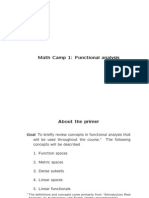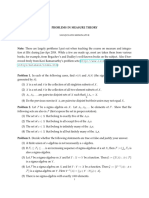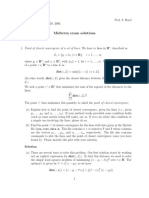Basis of A Topology
Basis of A Topology
Uploaded by
leadwin princewillCopyright:
Available Formats
Basis of A Topology
Basis of A Topology
Uploaded by
leadwin princewillOriginal Description:
Original Title
Copyright
Available Formats
Share this document
Did you find this document useful?
Is this content inappropriate?
Copyright:
Available Formats
Basis of A Topology
Basis of A Topology
Uploaded by
leadwin princewillCopyright:
Available Formats
MAT 411: Topology:
Basis of a Topology
Imaga Ogbu Famous
Department of Mathematics
Covenant University
Imaga O. F. (Dept. of Mathematics) Topology Topological Spaces 1/9
Objectives
After studying this module, the student will be able to
1 Define the basis for a topology
2 Solve problems related in basis for a topology
3 Describe the sub-base
4 State the standard topology
Imaga O. F. (Dept. of Mathematics) Topology Topological Spaces 2/9
Basis for a Topology I
Definition
Let (X, Y) be a topological space. A collection of open subsets B of
X is called a basis or basis for a topology if
(i) The union of elements of B is X
(ii) If x ∈ B1 ∩ B2 , B1 , B2 ∈ B, then there exists a B ∈ B such that
x ∈ B ∈ B1 ∩ B2
If B is a basis for a topology Y on a set X, then a subset A of X is in Y if
and only if it is a union of members of B
B generates Y i.e if we are given the sets that are members of B, we can
determine the members of Y - which are formed by taking the union of
members of B
Imaga O. F. (Dept. of Mathematics) Topology Topological Spaces 3/9
Basis for a Topology II
The elements of B are called basis elements.
Definition
Let B be a basis for a topology on X, then the topology Y generated
by B is described as follows:
A subset U of X is said to be an open set in X (that is, U ⊂ Y), if for
each U there is a basis element B ∈ B such that u ∈ B and B ∈ U.
Note that if B is a basis for Y, then B ⊆ Y.
Imaga O. F. (Dept. of Mathematics) Topology Topological Spaces 4/9
Basis for a Topology III
Example: Let (X, Y) be a discrete topological space and B be the
collection of singleton subsets of X; i.e. B = {{x} : x ∈ X}, then B is a
basis for Y.
Proof: Since Y is a discrete topology on X, it contains all the subset of X.
Let x0 ∈ X, then {x0 } ∈ B such that x0 ∈ {x0 }.
Also, if x0 ∈ B1 ∩ B2 , where B1 , B2 ∈ B, then
B1 = B2 = {x0 } ⇒ x0 ∈ {x0 } ⊆ B1 ∩ B2 .
Example: Let X = {a, b, c} and B = {{a}, {c}, {a, b}, {b, c}}. Show that
B is not a basis for any topology on X.
Example: Let X = {1, 2, 3, 4} and A = {{1, 2}, {2, 4}, {3}}. Determine
the topology on X generated by the elements of A and hence determine
the basis for the topology.
Imaga O. F. (Dept. of Mathematics) Topology Topological Spaces 5/9
Basis for a Topology IV
Example: Let X = {a, b, c, d} and A = {{a, b}, {b, c}, {d}}. Determine the
topology on X generated by the elements of A and hence determine the
basis for the topology.
Imaga O. F. (Dept. of Mathematics) Topology Topological Spaces 6/9
Topologies on the real line R
Standard Topology: Let B be the collection of all open intervals in R i.e.
B = {(a, b) : a, b ∈ R, a < b}. Then B is a basis for the euclidean
topology on R known as the standard topology on R.
Proof: for any x ∈ R, we have (x − 1, x + 1) ∈ B such that
x ∈ (x − 1, x + 1).
Next let x0 ∈ (a, b) ∩ (c, d). Then a < x0 < b, c < x0 < d. Consider
r0 = min{|x0 − a|, |x0 − c|}, s0 = min min{|b − x0 |, |d − x0 |}.
Then x0 ∈ (x0 − r0 , x0 + s0 ) ∈ (a, b) ∩ (c, d).
Lower Limit Topology: Let B ′ is the collection of all half open intervals
in R i.e. B = {[a, b) : a, b ∈ R, a < b}, the topology generated by B ′ is
called the lower limit topology on R. When R is given this topology it is
denoted by Rl
Imaga O. F. (Dept. of Mathematics) Topology Topological Spaces 7/9
K-topology: Let K denote the set of all numbers of the form n1 for
n ∈ Z+ , and let B ′′ be the collection of all intervals (a, b) along with all
sets of the form (a, b)/K. The topology generated by B ′′ is called the
K-topology. When R is given this topology it is denoted by RK .
B ′′ = {(a, b) : a, b ∈ R, a < b} ∪ {(a, b)/K : a, b ∈ R, a < b}.
Imaga O. F. (Dept. of Mathematics) Topology Topological Spaces 8/9
Sub-bases
Definition
Let (X, Y) be a topological space. Let S ⊂ Y such that S ̸= ∅.
The set S is said to be a sub-base for the Topology Y on X if finite
intersections of the members of S form a base for the topology Y on
X i.e the union of members of S give all the members of T. The
members of S are called sub-basic open sets.
Example: Let a, b ∈ R such that a < b, then (−∞, b) ∩ (a, ∞) = (a, b).
The open intervals (a, b) form a base for the standard topology on R.
Hence, the family of infinite open intervals form a sub-base for the
standard topology on R
Imaga O. F. (Dept. of Mathematics) Topology Topological Spaces 9/9
You might also like
- SolutionsDocument183 pagesSolutionsraipranshu125No ratings yet
- Folland Real Analysis Solution Chapter 2 IntegrationDocument6 pagesFolland Real Analysis Solution Chapter 2 IntegrationEdissonArcosNo ratings yet
- Plug-In Gait Model DetailsDocument23 pagesPlug-In Gait Model DetailsElbe MirandaNo ratings yet
- American Mathematics Olympiad Test-PreparationDocument1 pageAmerican Mathematics Olympiad Test-PreparationAytenn BashirliiNo ratings yet
- Lecture Notes in Measure Theory and IntegrationDocument40 pagesLecture Notes in Measure Theory and IntegrationpooyanghNo ratings yet
- MATH 254 Solutions 1Document5 pagesMATH 254 Solutions 1kuranityNo ratings yet
- Chapter 4 - Inner Product SpacesDocument80 pagesChapter 4 - Inner Product SpacesChristopherNo ratings yet
- Weaktopologies PDFDocument20 pagesWeaktopologies PDFAqeelNo ratings yet
- Irreducible PolynomialsDocument11 pagesIrreducible PolynomialsRamaswamy Koodalloor ParasuramanNo ratings yet
- Mat 771 Functional Analysis Homework 5Document5 pagesMat 771 Functional Analysis Homework 5Yilma ComasNo ratings yet
- Fixed Point ThoremDocument21 pagesFixed Point ThoremsurajyellowkiteNo ratings yet
- A Geometric Interpretation of The Riemann-Stieltjes IntegralDocument9 pagesA Geometric Interpretation of The Riemann-Stieltjes IntegralDiego Pizarro RocoNo ratings yet
- Functional Problems AnhLe FullDocument152 pagesFunctional Problems AnhLe FullThai An NguyenNo ratings yet
- Lecture-6 (Paper 1)Document26 pagesLecture-6 (Paper 1)Ask Bulls Bear100% (1)
- Math Camp 1: Functional AnalysisDocument50 pagesMath Camp 1: Functional AnalysisIme OkonnaNo ratings yet
- MCQ-Real AnalysisDocument26 pagesMCQ-Real Analysislulusutbk9No ratings yet
- Introduction To Metric SpacesDocument15 pagesIntroduction To Metric Spaceshyd arnes100% (1)
- Week 13Document17 pagesWeek 13JavierPaganLacambraNo ratings yet
- Functional Analysis Exam: N N + N NDocument3 pagesFunctional Analysis Exam: N N + N NLLászlóTóthNo ratings yet
- Lecture09 AfterDocument31 pagesLecture09 AfterLemon SodaNo ratings yet
- Complex Variables & Transforms (20A54302) : Lecture NotesDocument263 pagesComplex Variables & Transforms (20A54302) : Lecture NotesAl AminNo ratings yet
- FA 15 16 Ex4 solHWDocument11 pagesFA 15 16 Ex4 solHWboris peñaNo ratings yet
- HW10 SolDocument7 pagesHW10 SolVictor Valdebenito100% (1)
- 4 Countability Axioms: Definition 4.1. LetDocument13 pages4 Countability Axioms: Definition 4.1. LetMohammad Sauban100% (1)
- MTS 361 - Metric SpaceDocument21 pagesMTS 361 - Metric SpaceEmmanuel AyomikunNo ratings yet
- Functional AnalysisDocument8 pagesFunctional AnalysisJunaidvali ShaikNo ratings yet
- Solved ProblemsDocument7 pagesSolved ProblemsIrving JoséNo ratings yet
- MTL 411: Functional Analysis: 1 Hahn-Banach TheoremsDocument7 pagesMTL 411: Functional Analysis: 1 Hahn-Banach TheoremsAmbeswar PhukonNo ratings yet
- CompactnessDocument7 pagesCompactnessvamgaduNo ratings yet
- Measure Theory - SEODocument62 pagesMeasure Theory - SEOMayank MalhotraNo ratings yet
- Subject: Analysis Iv Lesson: Connectedness in Metric Spaces by Dr. Satya GoelDocument23 pagesSubject: Analysis Iv Lesson: Connectedness in Metric Spaces by Dr. Satya GoelJeoff Libo-onNo ratings yet
- Functions of Bounded VariationDocument30 pagesFunctions of Bounded VariationSee Keong Lee100% (1)
- 111aass4 SolutionsDocument7 pages111aass4 SolutionsSnežana MilosavljevićNo ratings yet
- Abstract Algebra ch13 Dummit Foote2 PDFDocument19 pagesAbstract Algebra ch13 Dummit Foote2 PDFThiago NobreNo ratings yet
- Algebraic Topology Solutions 3Document7 pagesAlgebraic Topology Solutions 3Chris Walsh100% (1)
- 8.3 The Range: Section I (Sequence)Document15 pages8.3 The Range: Section I (Sequence)Manish Acharyya ECENo ratings yet
- Problems - Measure TheoryDocument16 pagesProblems - Measure TheoryShivam kumar agrawal100% (1)
- Functional AnalysisDocument93 pagesFunctional Analysisbala_muraliNo ratings yet
- Midterm Exam SolutionsDocument26 pagesMidterm Exam SolutionsShelaRamos100% (1)
- NumericalMethodsT264UnitIIIByDrNVNagendram PDFDocument60 pagesNumericalMethodsT264UnitIIIByDrNVNagendram PDFPadam PrakashNo ratings yet
- Contraction PrincipleDocument21 pagesContraction PrincipleriyasNo ratings yet
- Solution 4Document3 pagesSolution 4nayana.prakashsuvarnakarNo ratings yet
- Fractional Calculus PDFDocument7 pagesFractional Calculus PDFShorouk Al- IssaNo ratings yet
- R.B.V.R.R Women'S College (Autonomous) Department of Mathematics M.Sc. Semester III Paper-III Syllabus 2017-18Document2 pagesR.B.V.R.R Women'S College (Autonomous) Department of Mathematics M.Sc. Semester III Paper-III Syllabus 2017-18Abhay Pratap SharmaNo ratings yet
- (GEM 601) Exercises For Special FunctionsDocument2 pages(GEM 601) Exercises For Special FunctionsAly Jr ArquillanoNo ratings yet
- Modes of Convergence: N N N NDocument4 pagesModes of Convergence: N N N NMRNo ratings yet
- Assignment For Group TheoryDocument2 pagesAssignment For Group TheoryAadil Aman0% (1)
- MAL-512 Book FinalDocument181 pagesMAL-512 Book FinalqudratqaroNo ratings yet
- Topology NPTEL Lecture Notes by Dr. VeermaniDocument124 pagesTopology NPTEL Lecture Notes by Dr. VeermaniYuvraj KulkarniNo ratings yet
- 2.2 Equivalence RelationsDocument5 pages2.2 Equivalence RelationsMd Rizwan AhmadNo ratings yet
- Assignment On Basic Linear AlgebraDocument1 pageAssignment On Basic Linear AlgebraSumit Kumar PandeyNo ratings yet
- Apostol Chapter 02 SolutionsDocument23 pagesApostol Chapter 02 SolutionsGeo JosNo ratings yet
- Module IV (QB)Document10 pagesModule IV (QB)sudheshNo ratings yet
- Complex AnalysisDocument180 pagesComplex AnalysisvrsafeNo ratings yet
- RG Overview of Complex Analysis and ApplicationsDocument8 pagesRG Overview of Complex Analysis and ApplicationsRohit KumarNo ratings yet
- Math 138 Functional Analysis Notes PDFDocument159 pagesMath 138 Functional Analysis Notes PDFAidan HolwerdaNo ratings yet
- Analisis FuncionalDocument18 pagesAnalisis Funcionalricky201201No ratings yet
- Topological SpacesDocument16 pagesTopological Spacesleadwin princewillNo ratings yet
- Mat 434 - 221102 - 231557Document9 pagesMat 434 - 221102 - 231557leadwin princewillNo ratings yet
- Mat 434 2 - 221102 - 232007Document9 pagesMat 434 2 - 221102 - 232007leadwin princewillNo ratings yet
- Mat 434 4 (2) - 221102 - 232126Document7 pagesMat 434 4 (2) - 221102 - 232126leadwin princewillNo ratings yet
- Topological SpacesDocument16 pagesTopological Spacesleadwin princewillNo ratings yet
- Understanding by Design: Design Topic - Perimeter, Area, Volume - Subject - Math - Grade 5 - Designer - Laura WillDocument7 pagesUnderstanding by Design: Design Topic - Perimeter, Area, Volume - Subject - Math - Grade 5 - Designer - Laura Willapi-496406588No ratings yet
- 81E MATHS PREP QP 2024 DDPI NORTH-2Document5 pages81E MATHS PREP QP 2024 DDPI NORTH-2deviyanikalaiyarasunNo ratings yet
- Quantum HealthDocument50 pagesQuantum HealthAB90% (10)
- Numb3rs Activities Curriculum AlignmentDocument6 pagesNumb3rs Activities Curriculum AlignmentSm KimNo ratings yet
- Study Planner CBSE CLASS IX - Phase-1 (Oct'20 To Jan'21)Document27 pagesStudy Planner CBSE CLASS IX - Phase-1 (Oct'20 To Jan'21)Yashwanta BRIJRAJNo ratings yet
- V.OPROIU - Bochner Flat Tangent BundlesDocument12 pagesV.OPROIU - Bochner Flat Tangent BundlesVasile OproiuNo ratings yet
- Area Under Curve (AUC) (Sol)Document3 pagesArea Under Curve (AUC) (Sol)Raju SinghNo ratings yet
- MA123 Lab 3 NotesDocument2 pagesMA123 Lab 3 NotesAhmed SohailNo ratings yet
- X Maths KS Sample PaperDocument6 pagesX Maths KS Sample PaperMukul SinghNo ratings yet
- Exercise 3Document4 pagesExercise 3Anant Preet SinghNo ratings yet
- JUPEB Maths2015Document14 pagesJUPEB Maths2015Izundu VictorNo ratings yet
- Area and Perimeter of L Shapes: 7 M 26 CM 21 YdDocument2 pagesArea and Perimeter of L Shapes: 7 M 26 CM 21 Ydatiqah90No ratings yet
- Laplace and Fourier Table PDFDocument1 pageLaplace and Fourier Table PDFafiqNo ratings yet
- TRIGONOMETRY PRACTICE SHEET 4th JanDocument1 pageTRIGONOMETRY PRACTICE SHEET 4th JanMedhamsh ReddyNo ratings yet
- Problemsheet 2Document6 pagesProblemsheet 2Kush ShahNo ratings yet
- Class 7 Algebraic Expressions Class 8 Visualising Solid Shapes & GraphsDocument1 pageClass 7 Algebraic Expressions Class 8 Visualising Solid Shapes & Graphstarun aroraNo ratings yet
- Cartesian System of Rectangular CoordinatesDocument12 pagesCartesian System of Rectangular Coordinatestekeshwara.pNo ratings yet
- DuctingDocument91 pagesDuctingapi-2734334210% (1)
- Practice Problems in Algebra, Trigonometry, and Analytic GeometryDocument7 pagesPractice Problems in Algebra, Trigonometry, and Analytic GeometryBhern Bhern100% (1)
- Class 9-Coordinate Geometry -Worksheet 1 (2024-25)Document3 pagesClass 9-Coordinate Geometry -Worksheet 1 (2024-25)rytd9wxwrzNo ratings yet
- Concept MapDocument3 pagesConcept Mapapi-247933688No ratings yet
- 0580 s22 QP 33 PDFDocument20 pages0580 s22 QP 33 PDFDeadBunnyNo ratings yet
- Functions and Their Rates of ChangeDocument234 pagesFunctions and Their Rates of ChangePeter JonesNo ratings yet
- Mathematics10 Q2 Mod22 V1.0Document24 pagesMathematics10 Q2 Mod22 V1.0Shine Casipe PinlacNo ratings yet
- Grade 2 Notation and Numeration CurriculumDocument11 pagesGrade 2 Notation and Numeration CurriculumBřï Ťť ÑëýNo ratings yet
- Topic 1 Plane TesselationDocument12 pagesTopic 1 Plane TesselationBryanQushaNo ratings yet
- Regular Curves Arc LengthDocument2 pagesRegular Curves Arc Lengthmelquisbert0No ratings yet
- Grade 10 Investigation Trig 2024Document9 pagesGrade 10 Investigation Trig 2024juniorkubikiNo ratings yet




























































































